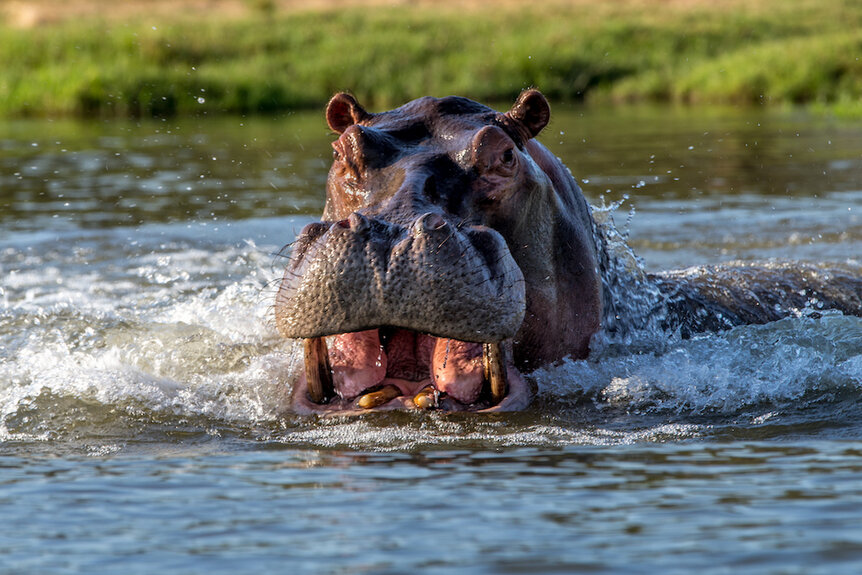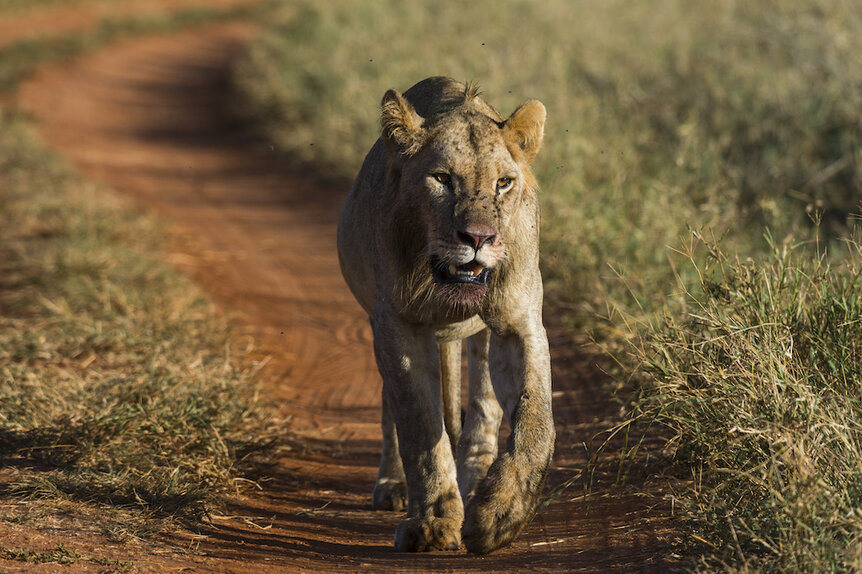Create a free profile to get unlimited access to exclusive videos, sweepstakes, and more!
Beast: The True Story Behind the Man-Eating Lions of Tsavo
What happens when the hunter becomes the hunted?
Idris Elba is taking on man-eating lions these days, starring in the recent survival thriller, Beast. Elba plays Dr. Nate Samuels, a man on a vacation to a South African nature preserve with his two daughters. The trip is an attempt to reconnect with them in the wake of their mother’s death, but the emotional stakes take a back seat to more primal priorities when the group is stalked by a ravenous lion with a taste for revenge... and perhaps human flesh.
For the most part, humans enjoy a privileged position within nature, having largely separated ourselves from most predators. However, under the right conditions, we can find ourselves on the business end of gnashing teeth and claws. Beast takes this idea to its extreme by introducing a predator which hunts humans not just opportunistically but by preference. We’re left to wonder if this is wholly the product of Hollywood storytelling or if there are really animals out there trying to dethrone humanity from the top of the food chain.
The True Story of the Tsavo Lions
Certainly, people sometimes find themselves in precarious situations which place them squarely on the menu of a predatory animal. It’s a problem not often encountered when living in cities and that’s where the majority of humanity spends their time. Moreover, the world’s wilderness is shrinking; only about a quarter of the planet is considered to be wild and most of that wilderness is located in just five countries. Of course, that only takes into account the land masses.
Stepping into one of the world’s oceans necessarily places you in a wild environment, one which we are not well adapted to, and which is filled with predators. That’s probably why we have such an enduring fear of sharks. However, sharks are mostly accidental predators of humans. Shark attacks are believed to be the result of curiosity or confusion and are almost never the result of a targeted attack on humans. The odds of being the victim of a shark attack are vanishingly small. The odds of that shark having a preference for human meat, even more so. That isn’t necessarily the case on land.
Land-based animals are much more likely to develop a taste for humans than their oceanic counterparts. If you find yourself in sub-Saharan Africa, humanity’s ancestral home, there are dozens of animals who are more than happy to take a bite out of you if given half a chance. On paper, lions seem like the obvious threat. They’re large predatory carnivores and they push all of the right fear buttons. That said, they don’t even crack the top ten of the most dangerous animals on the continent. That dubious honor goes to the mosquito. Even taking arthropods out of the mix, you’re more likely to meet your end at the proverbial hands of a snake, crocodile, elephant, or hippo than a lion.
That isn’t to say lions won’t take down a human if they have the opportunity. It’s unclear how many lion attacks happen every year because they aren’t all reported. Estimates range from about 20 to 250. It’s not that lions are necessarily hunting people on purpose, but they see just about anything that moves as a potential prey item, including people. We might even be particularly interesting to them because of our lack of speed or biological weapons like claws or horns.
According to Nature, there were 563 reported deaths and 308 injuries resulting from lion attacks between 1990 and 2004. The number suggests that if you find yourself in the grip of a lion, there’s a roughly two-thirds chance it’s the last thing you’ll ever see. Those attacks largely happen when people are out in fields harvesting crops and when the availability of other prey items is low.
Despite those terrifying statistics, your average lion isn’t stalking through the brush on the hunt for humans. More than half of their diet is comprised of scavenged meat and the rest is mostly made up of non-human animals. A single lion attack is tragic and frightening enough, but the worst-case scenario is a lion, or lions, who develop a preference for people and hunt them preferentially. It’s something that has happened at least once.
The Tsavo Man-Eating Lions
In 1898, a group of railway workers were laying track across the Tsavo river in the Coast Province of Kenya when they fell victim to a pair of lions. Unlike most lion attacks, however, this wasn’t a one-time incident. Over the course of nine months, beginning in March of that year, the two lions systematically hunted the workers taking dozens of victims.
By some accounts, the lions snuck into the camp at night, pulled people from their tents, and killed them within earshot of the rest of the camp. It would have been the stuff of nightmares, the sorts of things we imagine on screen but don’t expect to happen in real life. In the more than a century since the attacks occurred, seven feature films have been inspired by the Tsavo lions, including Beast, to some extent. (The Ghost and the Darkness, starring Val Kilmer and Michael Douglas, is probably the most famous and relatively faithful telling of the story.)
John Patterson, a British colonel made several attempts to trap and kill the lions and eventually succeeded in December of 1898. He subsequently published a book about the events which counted the death toll at 28. A later edition of the book, which purported to include deaths of locals not working at the railway camp, upped the body count to 135. After their deaths, the Field Museum of Chicago purchased the skulls and skins and mounted them. They remain on display in the Field Museum today.
In recent years, scientists took bone and hair samples from the Tsavo lions’ remains in an effort to determine once and for all just how deadly they were. They searched the samples for isotopes of carbon-13 and carbon-12 as a means of determining their diets in the final months of their lives.
When we eat, we acquire isotopes from our food and the ratio of those isotopes can grant clues as to what we’ve eaten. By measuring the ratio of carbon-13 and carbon-12 in their tissues, researchers were able to more closely estimate what percentage of the lions’ diet was comprised of humans.
The results come in at the lower end of Patterson’s estimates. Isotopic analysis suggests that humans made up about 30 percent of their overall diet during the last three months of their lives. Extrapolating that out over nine months and estimating the average size of a person and the average amount of food a lion needs to eat, they landed at roughly 35 victims. Moreover, the analysis revealed the majority of the killing was carried out by one of the lions, who is estimated to have been responsible for 25 of the deaths.
One has to wonder what drove these two lions to seek out humans as a mainstay of their diets. There were likely a couple of elements at play. First is a drought that hit the region around that time and second is a disease called rinderpest, otherwise known as cattle plague, which decimated prey populations like buffalo and wildebeest. The lions were likely struggling for food and the presence of a large group of humans made for a ready substitute.
The lines between humans and lions continue to cross to this day and attacks, opportunistic or otherwise, aren’t a strange anomaly. They are to be expected. The lion in Beast, though, is still something special.
Originally published Aug 31, 2022.
































